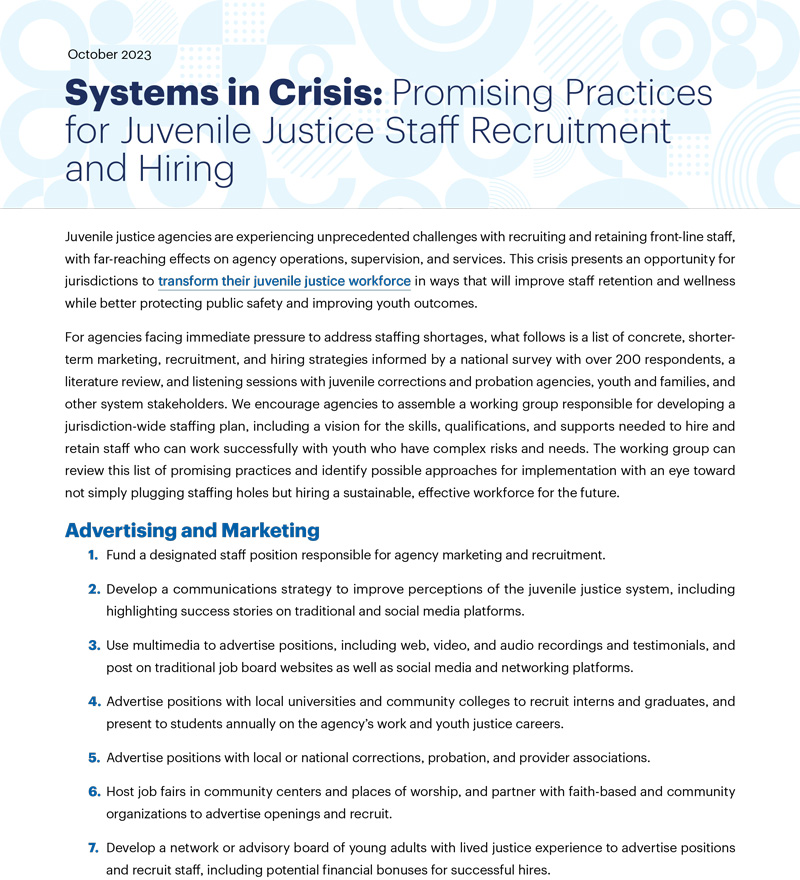
Staff Recruitment and Hiring
Juvenile justice agencies are experiencing unprecedented challenges with recruiting and retaining front-line staff, with far-reaching effects on agency operations, supervision, and services. This crisis presents an opportunity for jurisdictions to transform their juvenile justice workforce in ways that will improve staff retention and wellness while better protecting public safety and improving youth outcomes.
For agencies facing immediate pressure to address staffing shortages, what follows is a list of concrete, shorter-term marketing, recruitment, and hiring strategies informed by a national survey with over 200 respondents, a literature review, and listening sessions with juvenile corrections and probation agencies, youth and families, and other system stakeholders. We encourage agencies to assemble a working group responsible for developing a jurisdiction-wide staffing plan, including a vision for the skills, qualifications, and supports needed to hire and retain staff who can work successfully with youth who have complex risks and needs. The working group can review this list of promising practices and identify possible approaches for implementation with an eye toward not simply plugging staffing holes but hiring a sustainable, effective workforce for the future.
Advertising and Marketing
- Fund a designated staff position responsible for agency marketing and recruitment.
- Develop a communications strategy to improve perceptions of the juvenile justice system, including
highlighting success stories on traditional and social media platforms. - Use multimedia to advertise positions, including web, video, and audio recordings and testimonials, and
post on traditional job board websites as well as social media and networking platforms. - Advertise positions with local universities and community colleges to recruit interns and graduates, and
present to students annually on the agency’s work and youth justice careers. - Advertise positions with local or national corrections, probation, and provider associations.
- Host job fairs in community centers and places of worship, and partner with faith-based and community
organizations to advertise openings and recruit. - Develop a network or advisory board of young adults with lived justice experience to advertise positions
and recruit staff, including potential financial bonuses for successful hires.
Qualifications, Experience, and Position Descriptions
- Establish job titles that reflect the agency’s mission and desired qualifications and that are attractive to
more educated professionals (youth development specialists, case managers, etc.). - Ensure that job descriptions accurately describe the true nature of the work and promote the agency’s
mission of rehabilitation rather than surveillance and punishment. - Allow for flexible education, credentialing, and experience requirements to attract the largest possible
applicant pool. - Establish priority hiring qualifications such as youth development experience or lived experience in the
juvenile justice system. - Identify and detail components of the job that may be done remotely as well as opportunities for flexible
schedules, comp time, overtime, and performance and longevity bonuses. - Identify and detail more expedited promotional pathways as part of job descriptions so staff see the
opportunity as a potential career instead of just a job.
Salary Levels and Financial Incentives
- Conduct a market salary analysis to determine what salary levels are needed to competitively recruit and
retain qualified staff and are commensurate with the challenges of the work. - Increase starting salaries and establish annual increases, at minimum, aligned with inflation.
- Provide initial hiring bonuses (received only if staff stay a minimum period of time).
- Offer benefit incentives such as additional vacation time, flex time, overtime, transportation stipends,
professional development funds, and tuition reimbursement.
Application Process
- Use automated web applications that can expedite and streamline the hiring application process, screening,
and communication with applicants and mandate required timeframes for the hiring process. - Conduct candidate interviews virtually or in the community to reduce transportation barriers.
- Facilitate on-site hiring “blitzes” at job fairs where applicants can complete an application, background
check, and interview on the same day. - Send automated text reminders at critical intervals of the application and interview process.
- Standardize screening tools and questions for all applications to minimize time and hiring bias.
- Include competency-based tools or interviews to ensure that candidates have the required skills and
approaches to succeed at the job. - Include front-line staff, youth, and people with lived experience on the interview panel.
Partnerships and Workforce Pipelines
- Coordinate with other youth and family service agencies on marketing and hiring strategies, standardize
pay to reduce interagency competition, host joint recruiting events, and share resumes from prospective
clients that might be good fits with other agencies. - Partner with colleges, universities (including HBCUs), and vocational programs to offer paid internships,
educational credits, and training programs. - Create juvenile justice and youth development credentialing, certificate, or apprenticeship programs with
local universities, workforce boards, and community providers. - Partner with community and faith-based organizations to develop mentoring, credible messenger, and
volunteer programs that can supplement agency staff. - Remove licensure and other administrative barriers to allow people with lived experience and other credible
messengers to work within the system, including inside juvenile facilities.

This brief was prepared by The Council of State Governments Justice Center with support from the U.S. Department of Justice’s Office of Justice Programs’ Office of Juvenile Justice and Delinquency Prevention through grant number 15PJDP-21-GK-03216- JRIX. The opinions, findings, and conclusions or recommendations expressed in this publication are those of the authors and do not necessarily reflect those of the U.S. Department of Justice.

